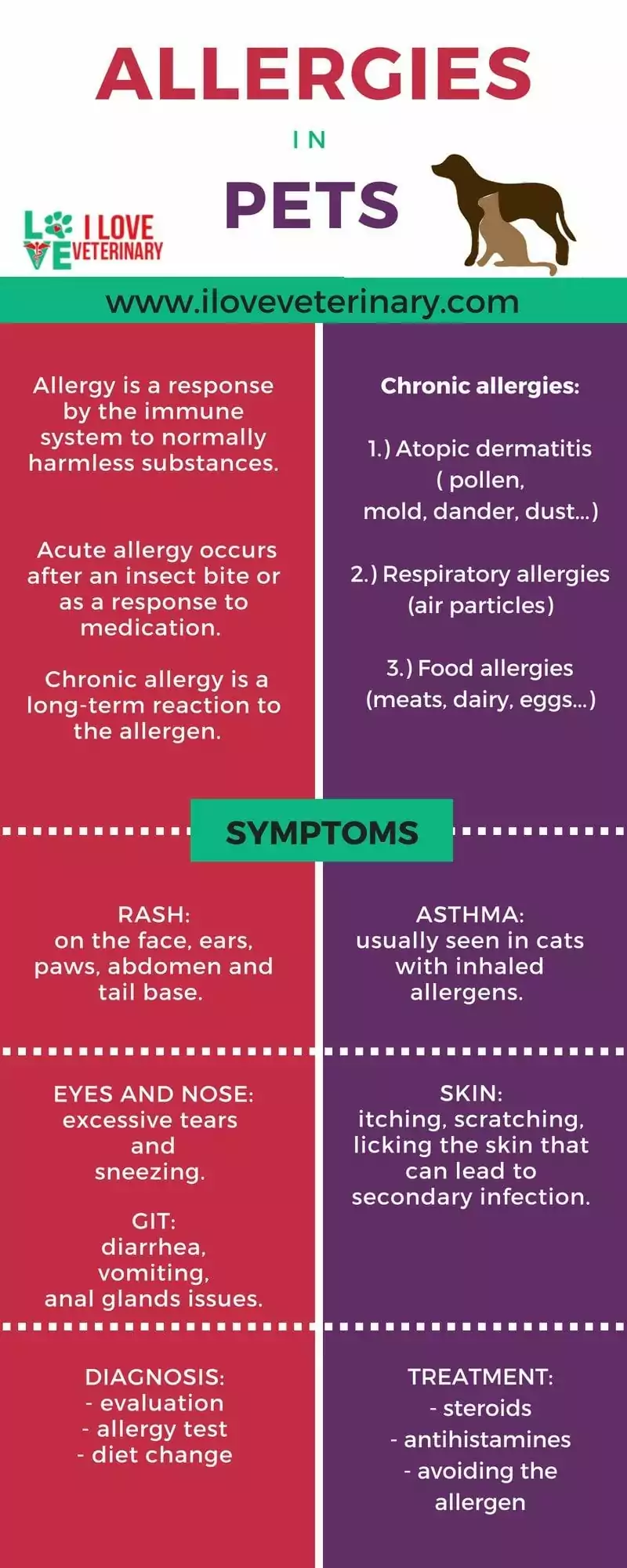Allergies in pets are the body’s way of communicating that there are certain substances it doesn’t like. As well as people, pets can develop allergies too. The allergic reaction can be acute (immediate onset) or chronic (during a prolonged period of time).
Here is an infographic about the types of allergies pets experience, the basic symptoms, and diagnosis and treatment.
Get this as a poster for your clinic or classroom! Order HERE!

Allergies in Pets
Every pet, just like humans, can suffer from allergies. Allergy symptoms in pets are very similar to those of their human companions and include itchy skin, irritated eyes, runny nose or sneezing, watery eyes, and continuous scratching.
When allergies attack your pet you should not hesitate to take it to a veterinarian for professional advice. Veterinarians have numerous solutions that may help you keep allergies under control while preventing them from becoming an allergy issue that affects your entire budget at the same time.
One of the most common allergies amongst dogs is related to its food regimen; if there is food intolerance or allergies with certain grains such as wheat or corn this will result in allergies in pets. This proves that allergies are not caused by your pet but that they are contracted during their lifetime.
Causes of Allergies in Pets
Allergic reactions in dogs may also be triggered because of the following:
- Pollen allergies
- Flea allergies
- Food allergies
- Dry skin allergies
Pet allergies are very similar to human allergies and it is difficult for your veterinarian to make out what is causing your dog this discomfort without first running allergy tests. This means that you will have to observe your pet’s behavior to determine which could be the cause of its allergies.
If you find small lumps rising on certain spots, then you would probably suspect fleas as being the culprit behind these allergies in pets. Also, watch out for dry or flaky areas on their skin, allergies may also be caused by allergies with food.
What Should I do if my Pet Has an Allergy?
If you notice that your pet is scratching itself excessively the veterinarian will have to run some allergy tests in order to make out what allergies your pet might have contracted around its area or neighborhood.
Once this has been determined your vet can give you advice on how to proceed with making your pet’s allergies go away for good.
During the examination of allergies in pets, small discs are taken from the inside of their ears where bacteria are likely to thrive. These samples are then analyzed under a microscope in order to determine if there is an allergic reaction developing against certain allergens found on the surface of the skin or inside their body.
Allergy testing is very important so do not hesitate to take your pet to a vet for allergies.
Once allergies have been diagnosed and allergies in pets have been detected, the best solution is to remove the allergen causing the allergies from your pet’s diet as much as you possibly can.
Once this has been done, spend some time helping your pet get used to its new regimen of food that will no longer cause allergies such as wheat or corn allergies.
Supplements for Allergies in Pets
You may want to give your pet supplements like Omega 3 fatty acids or Omega 6 fatty acids. These nutrients will help alleviate allergic reactions and make them less frequent and less severe when allergies do happen.

If you give these essential nutrients it should also be easy for you and your veterinarian to come up with an accurate diagnosis on exactly what allergies may be affecting your pet.
